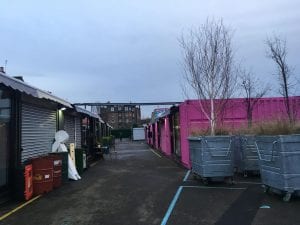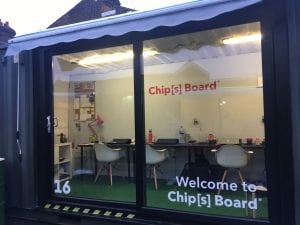Your pantry has everything you need to make plastic
The best thing about a city is all the people that it brings together. Diversity of people = exchange of ideas = BAM! progress. This formula has persisted through hundreds of generations: when people get together they really do have the power to drive change. This makes a city a great place for people to collaborate on ways to make improvements to how we use our resources.
On a whim, a friend and I went to a workshop lead by a women who is interested in making bioplastics: materials made from natural ingredients. Her “lab” is located among many other labs that are all inside of shipping containers. While my attention was drawn to the word “bio”, what we found in that room were not biologists but artistically minded people who were passionate about creating things in a way that was environmentally friendly. I listened intently as they shared their recipes for creating natural dyes and a wide range of natural materials.
Apparently you can make plastic-like materials from ingredients as simple and natural as these.
As I sat there trying to process how exactly I had ended up in a discussion about such a niche subject in such an intimate environment, I also realized that I was insanely lucky to have ended up here, deeply immersed in a world that was completely out of my element. I can’t say that cooking up bioplastics in my kitchen is my passion or my calling, yet I left feeling inspired by the passion that filled that room. Sitting there, I learned that age old lesson: it’s not about how much power you have, but about the belief that you have it and how you use it. While I had to actively silence the cynical part of myself that wanted more scientific proofs and a larger scale agenda, I have to acknowledge that sometimes a person has to be a little bit crazy to do anything meaningful. These people realize that to make progress you have to start somewhere, and what better place to start than in a pink shipping container?
The container park, each crate housed a different lab or office space (our workshop was in a pink one).
To truly quiet that cynicism in all of us, this little shipping container park has already produced some success stories. Chips Board uses potato scraps from the McCain potato company and use it to make cardboard like materials that are used to make clothes, furniture and a variety of other products.
Lab grown meat (but like, is it vegan?)
In part two of the saga “Mika Ventures Into Niche Scientific Communities She Doesn’t Belong To”, my friend invited me to a launch event for a company called Cellular Agriculture UK. Not knowing exactly what this event would be, I found myself among many similar looking young professionals with round glasses and pressed collared shirts, and women wearing an assortment of “vegan” themed shirts. Looking up and down at myself, dressed in nice but unassuming clothes, I figured I could disguise myself as vegan if necessary.
Cellular Agriculture in a nutshell, is a company which is looking towards developing what is known as “Clean Meat”, that is, meat that has been grown from animal cells in a lab, but that does not require actually killing the animal. The biologist in me was fascinated by the science behind this, and the concepts of developmental biology that are being utilized towards essentially growing meat outside of the animal that it comes from. While many strides have been made, this process has yet to be fully conceived and perfected, making this area of research ripe for investigation.
The Cellular Agriculture logo looks like a little cell, enough to draw me to the event which was mostly non-scientific.
The bigger focus of the talks were about the implications of Clean Meat, and what regulations and industries would need to be in place for it to become a feasible, practical practice. Clean Meat in its ideal form would mean a reduced carbon footprint, less animal harm, less waste, and could also have various health benefits. Thus, a variety of people are interested in the cause, and not all of them vegan, much to my relief.
Sitting there, it began to dawn on me that while it may sound far-fetched at the moment, Clean Meat truly has the power to revolutionize the meat industry and agriculture around the world. As a biologist, I know that the science will get there eventually, just as it always does. With today’s tools, growing meat in a lab is not a theoretical concept but a reality, simply requiring more streamlining and studies to perfect its quality. However, to make Clean Meat accessible and cheap to the entire population, many industrial changes would have to occur. Ultimately, butchering animals could become a thing of the past, which could mean that animals could be grown in better conditions without the industrial pressure to reproduce often, and without feeding them outrageous amounts of cheap corn to ensure they are “meaty”. However, this requires a fair bit of reimagining, since it is hard to picture our world today in the absence of mass producing cattle farms. Along with reimagining a world without the current system, Clean Meat requires its own set of industries and regulations, many of which are still unknown. Finally, there is the issue of public acceptance, which, when it comes to food has been known to waver as was seen with the rejection of GMO’s.
Ultimately, I was largely convinced that Clean Meat, if done right, holds a lot of promise for solving many of the environmental, ethical, and health problems that are exacerbated by the current meat industry. For Clean Meat to become feasible, the system would have to be completely reimagined, however as is seen across history with the invention of earth changing technologies, humans are much more adaptable than we often give ourselves credit for.



